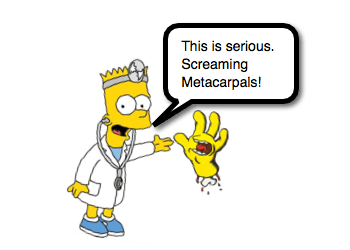Metacarpal Fractures

Metacarpal Fractures: Basics
- The hand is one of the most frequently injured body part of a child. [Mahabir, 2001; Hastings, 1984]
- The most common metacarpal fracture is the Boxer’s Fracture (neck of the 5th metacarpal). [Vadivelu, 2006; Mahabir, 2001]
- Fracture displacement is more common with metacarpal fractures. [Hastings, 1984]
- Almost all metacarpal fractures will heal clinically by 3-4 weeks. [Hastings, 1984]
Metacarpal Fractures: Age Matters
- Pediatric hand fractures have a biphasic peak. [Vadivelu, 2006]
- Small peak in toddlers and preschool children.
- More mobile and curious, but not super coordinated to get out of trouble
- Younger children are more often injury their fingers (ex, getting them crushed in doors– little fingers vs doors — never a good thing).
- Larger peak in 2nd decade of life (10-20 years). [Godfrey, 2017; Mahabir, 2001; Hastings, 1984]
- Sporting events are often associated [Vadivelu, 2006; Mahabir, 2001]
- Repeated hand fractures found to be associated with psychiatric illness. [Ozer, 2010]
- Small peak in toddlers and preschool children.
- The physis makes pediatric hand fractures unique.
- Angular forces can lead to epiphyseal injuries.
- Salter-Harris type II fractures are the most common type of epiphyseal fracture.
- Nonepiphyseal fractures are more common, though, in the metacarpals than in the phalangeal bones. [Vadivelu, 2006; Mahabir, 2001]
- Metacarpals usually get axial compressive forces, which the epiphyses is resistant to.
- Fighting / punching and sporting events lead to compressive forces.
Metacarpal Fractures: Location Matters
Metacarpal fractures are categorized as involving the:
- Head
- Rare
- Intra-articular
- Associated with avascular necrosis and growth arrest. [Williams, 2013]
- Require anatomic fixation
- Can be challenging to appreciate in children. [Godfrey, 2017]
- Neck
- Commonly seen with 2nd-5th metacarpals. [Mahabir, 2001]
- Compressive forces are more likely to lead to fractures here. [Mahabir, 2001]
- Shaft
- Uncommon
- Distributed among 2nd-5th metacarpals
- Often have an oblique or spiral pattern (rotational forces)[Sivit, 2013]
- Base
- Commonly seen with 1st digit and 5th metacarpals [Sivit, 2013]
- Are high energy injuries.
- May develop compartment syndrome.
- Can be either intra- or extra-articular
- Extra-articular fractures are more common
- In skeletally immature children, these may involve the physis.
- Bennett’s Fracture [Godfrey, 2017]
- An intra-articular fracture and dislocation at the base of the 1st metacarpal.
- Mechanism = fall on flexed thumb
- The metacarpal subluxes proximally and radially with small fragment remaining attached to the ligaments.
- Pediatric variants include Salter-Harris type III and IV fractures. [Godfrey, 2017]
- These are unstable and require surgical repair.
- Reverse Bennett’s Fracture – similar fracture pattern involving the 5th metacarpal.
Metacarpal Fractures: Deformed?
- Rotational deformity is not tolerable.
- Angular deformity can be tolerated … to some degree:
- 2nd Metacarpal Neck – <10 degrees
- 3rd Metacarpal Neck – <20 degrees
- 4th Metacarpal Neck –<30 degrees
- 5th Metacarpal Neck – <40 degrees
- Radially angulation is typically more stable than ulnarly angulated fractures. [Williams, 2013]
- May require surgical repair for rotation or substantial angulation.
Moral of the Morsel
- Age plays a role in hand injury patterns. Younger – fingers; Older – metacarpals
- No rotation allowed! Angular deformity is ok… know the degrees!
- Be leery of the thumb fracture! Bennett’s fracture is not a simple metacarpal fracture.
References
Godfrey J1, Cornwall R. Pediatric Metacarpal Fractures. Instr Course Lect. 2017 Feb 15;66:437-445. PMID: 28594520. [PubMed] [Read by QxMD]
Sullivan MA1, Cogan CJ, Adkinson JM. Pediatric Hand Injuries. Plast Surg Nurs. 2016 Jul-Sep;36(3):114-20. PMID: 27606586. [PubMed] [Read by QxMD]
Sivit AP1, Dupont EP, Sivit CJ. Pediatric hand injuries: essentials you need to know. Emerg Radiol. 2014 Apr;21(2):197-206. PMID: 24158746. [PubMed] [Read by QxMD]
Williams AA1, Lochner HV. Pediatric hand and wrist injuries. Curr Rev Musculoskelet Med. 2013 Mar;6(1):18-25. PMID: 23264097. [PubMed] [Read by QxMD]
Chew EM1, Chong AK. Hand fractures in children: epidemiology and misdiagnosis in a tertiary referral hospital. J Hand Surg Am. 2012 Aug;37(8):1684-8. PMID: 22763063. [PubMed] [Read by QxMD]
Ozer K1, Gillani S, Williams A, Hak DJ. Psychiatric risk factors in pediatric hand fractures. J Pediatr Orthop. 2010 Jun;30(4):324-7. PMID: 20502230. [PubMed] [Read by QxMD]
Vadivelu R1, Dias JJ, Burke FD, Stanton J. Hand injuries in children: a prospective study. J Pediatr Orthop. 2006 Jan-Feb;26(1):29-35. PMID: 16439897. [PubMed] [Read by QxMD]
Mahabir RC1, Kazemi AR, Cannon WG, Courtemanche DJ. Pediatric hand fractures: a review. Pediatr Emerg Care. 2001 Jun;17(3):153-6. PMID: 11437136. [PubMed] [Read by QxMD]
Bhende MS1, Dandrea LA, Davis HW. Hand injuries in children presenting to a pediatric emergency department. Ann Emerg Med. 1993 Oct;22(10):1519-23. PMID: 8214828. [PubMed] [Read by QxMD]
Hastings H 2nd, Simmons BP. Hand fractures in children. A statistical analysis. Clin Orthop Relat Res. 1984 Sep;(188):120-30. PMID: 6467708. [PubMed] [Read by QxMD]


Can metacarpal fractures heal successfully without surgery.